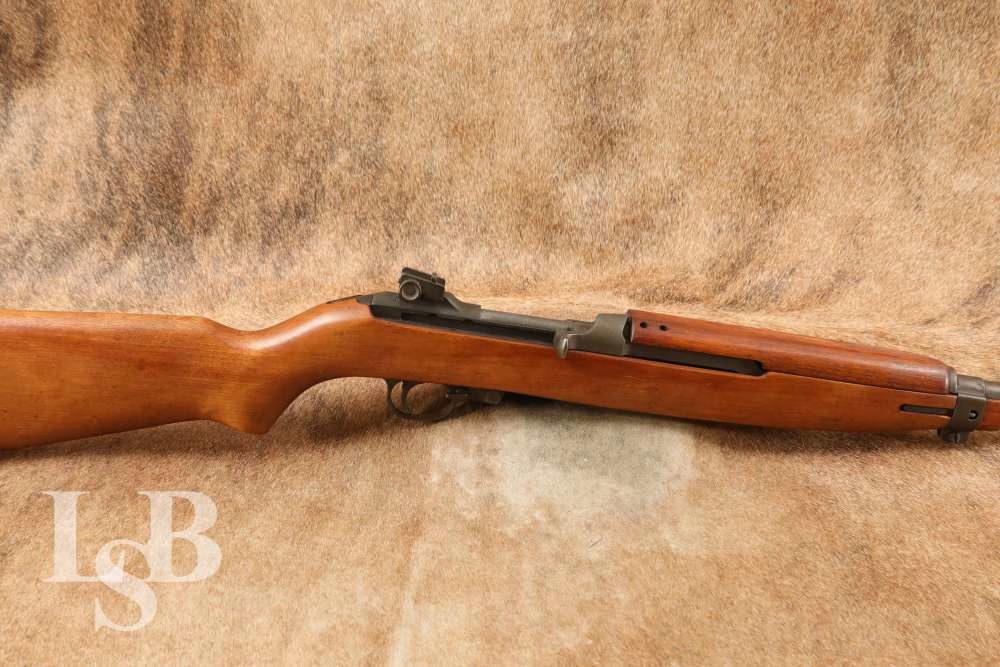
WWII Inland Division M1 Carbine .30 Cal Semi Auto Anniston Arsenal 1942 C&R
SOLD FOR: $1,300.00
LSB#: LSB250512SG098
Make: Inland Division of General Motors
Model: M1 Carbine
Serial Number: 389922
Year of Manufacture: Most likely late 1942, barrel date 9-1952
Caliber: .30 Cal Carbine
Action Type: Semi-Automatic carbine fed by detachable magazines.
Markings:
The top of the receiver is marked, “U.S. CARBINE CAL. 30 M1 / INLAND DIV. 389922”.
The magazine release is marked “M”
The rear sight is marked Shield “H”-Hemphill MFG. Co.
The Lug is unmarked
The stock is marked “SA” on the inside of the forend Springfield Armory postwar replacement stock. The grip is stamped with a “P” acceptance stamp. The left flank is stamped with “AN” for Anniston Arsenal signifying a post war rebuild or rework.
The upper handguard is unmarked
The trigger group is marked “INLAND”
The hammer is marked “H.I.” for Hillerich Machine Company.
The Rotary safety is marked “SS” a post war rebuild part.
The slide is marked “7160091 W” and “PI” on the inside. For Packard Inland.
The barrel is marked “S A 9 52” This is a post war Springfield Armory barrel. The barrel flat has a faint ordnance wheel stamp and the top of the barrel has a “P’ stamp about 6.5” back from the front sight.
The front sight is unmarked
The barrel band is marked “SI” for Inland Division.
The sear is marked “PI”
The oiler is marked “II” for International Silver Co.
Barrel Length: 18″
Sights / Optics: The front sight is a fixed blade set between protective ears. The rear sight is the later style sliding aperture sight with a serrated windage knob dovetailed to the receiver.
Stock Configuration & Condition: The stock is an Oval cut, low wood stock, with a four rivet handguard, type three barrel band with bayonet lug, a rotary safety and a checkered metal buttplate. The LOP measures about 13.25” from the front of the trigger to the back of the buttplate. The wood shows scattered minor marks, compressions and lines. The nose is missing a small chip on the left side. There are no visible cracks. The metal buttplate has turned brown with age and developed some very light surface rust yet retains the checkering. Overall this post war replacement stock is in Very Good condition.
Magazine Quantity & Condition: None.
Type of Finish: Parkerized
Finish Originality: Refinished.
Bore Condition: The bore is bright with defined rifling. There is no visible erosion or pitting. In this writer’s opinion the bore rates 9.25/10.
Overall Condition: The rifle retains 98% of its metal finish. The finish is beginning to turn brown green from oil, age, and cleaning. The bolt and action show minor finish loss on the friction surfaces. The markings are mostly clear and the screw heads are sharp with a few minor tool marked slots. The inside of the magazine well shows some surface rust as do the recesses of the front sight. Overall this rifle is in Very Good condition.
Mechanics: The action functions correctly. We did not fire this rifle. As with all used firearms, a thorough cleaning may be necessary to meet your maintenance requirements.
Box, Paperwork & Accessories: This rifle includes a canvas sling.
Our Assessment: This Inland Division M1 Carbine, originally manufactured in 1942, is an excellent example of how U.S. military rifles evolved through post-war service and arsenal refurbishment programs. Inland was the largest producer of M1 Carbines during WWII, leveraging the massive industrial resources of General Motors to produce over 2.6 million units. Designed to provide greater firepower than a sidearm while being more compact than the M1 Garand, the M1 Carbine was widely issued to officers, airborne troops, vehicle crews, and rear-echelon personnel. Its .30 Carbine cartridge, lightweight profile, and semi-automatic action made it one of the most versatile infantry weapons of the war.
This example bearing a Springfield Armory barrel dated 1952 and the “AN” (Anniston Arsenal) marked stock reflect the carbine’s continued use and maintenance in the post-WWII era. After the war, the U.S. military began a large-scale overhaul of its weapons stockpile. Anniston Arsenal, located in Alabama, was a major center for small arms repair and refurbishment. Carbines sent there were often rebuilt with a mix of original and replacement parts, inspected, and reissued for service in Korea and beyond. This particular rifle represents that journey, starting life in 1942 combat-ready form, then being re-barreled with the Springfield Armory barrel a decade later and re-furbed by Anniston Arsenal, ready to serve again. The M1 Carbine continued to see frontline use through the Korean War and even into Vietnam, valued for its handling and reliability, proving itself over multiple generations of conflict. To better understand this M1 carbine please see our high quality photos via the link and best of luck with your bidding!!!-R.L.

